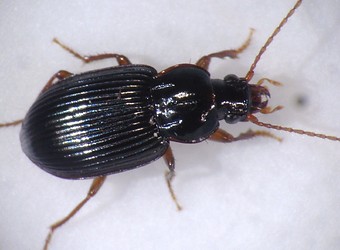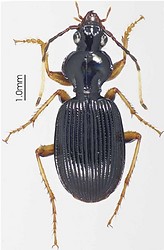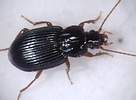Gondwanalox clade
Kipling Will


This tree diagram shows the relationships between several groups of organisms.
The root of the current tree connects the organisms featured in this tree to their containing group and the rest of the Tree of Life. The basal branching point in the tree represents the ancestor of the other groups in the tree. This ancestor diversified over time into several descendent subgroups, which are represented as internal nodes and terminal taxa to the right.

You can click on the root to travel down the Tree of Life all the way to the root of all Life, and you can click on the names of descendent subgroups to travel up the Tree of Life all the way to individual species.
For more information on ToL tree formatting, please see Interpreting the Tree or Classification. To learn more about phylogenetic trees, please visit our Phylogenetic Biology pages.
close boxIntroduction
Gondwanalox clade is an informal name for Loxandrini + Abacetini. Member taxa are distributed in tropical and subtropical regions, with a few, almost certainly more recently derived species found in temperate zones. Most taxa are found in wet habitats and are normally collected in swampy or riparian situations. Loxandrines are restricted to Australia, New Guinea, New Caledonia, Tasmania, South and Central America and mid to eastern North America as far north as the Great Lakes. Abacetines have a complementary distribution, ranging from Africa and southern Europe, across the Asian tropics to reach as far as northeastern Australia.
Characteristics
The adult and larval morphology of the included taxa have no single identifying characteristic nor is there a constant set of derived states that define this clade. The list below is mostly a collection of absence-state characteristics or plesiomorphic combinations that separates them from other groups that might be seen as similar.
Gondwanalox taxa are Harpalinae that have ALL of the following states:
- Lack angular base of stria one (present in many other carabids)
- Maxillary palpifer with a single seta positioned near base (multiple setae or a single seta near the middle is found in various other taxa)
- Filiform antennae (moniliform in drimostomatines, morionines and other taxa)
- Mouth parts without numerous long stiff setae (numerous long setae in chaetogenyines)
- Obvious suture medially between mentum and submentum (lacking in metiines)
- Abdominal sterna without deep punctures or sulci (present in various pterostichines)
- Tarsal claws smooth (pectinate in various other taxa)
- Brown to black, often iridescent (clear metallic colors found in various other taxa)
Discussion of Phylogenetic Relationships
There have been several authors that discussed the possible association of loxandrines with abacetines (Van Emden 1949; Arndt 1988; Bousquet 1985; Straneo, 1991; Bousquet & Larochelle 1993; Bousquet 1999). This was also the result found in a cladistic analysis of morphological characters (Will 2000); however, the arrangement and monophyly was questionable and character support was minimal in that study of a rather limited set of taxa. In a later analysis that was focused on testing monphyly of Loxandrini based on morphology and sequence data from multiple gene loci, the Gondwanalox clade is always recovered (Will unpublished). The monophyly of Loxandrini is also well supported, while monophyly of Abacetini is still uncertain.
Title Illustrations

| Scientific Name | Abacetus sp |
|---|---|
| Specimen Condition | Dead Specimen |
| Identified By | K.Will |
| Life Cycle Stage | Adult |
| Image Use |
 This media file is licensed under the Creative Commons Attribution License - Version 3.0. This media file is licensed under the Creative Commons Attribution License - Version 3.0.
|
| Copyright |
© Kipling Will

|
| Scientific Name | Stolonis tapiai |
|---|---|
| Location | Ecuador |
| Specimen Condition | Dead Specimen |
| Identified By | K.Will |
| Sex | Male |
| Life Cycle Stage | Adult |
| Body Part | Habitus |
| View | Dorsal |
| Collection | EMEC |
| Type | Paratype |
| Image Use |
 This media file is licensed under the Creative Commons Attribution License - Version 3.0. This media file is licensed under the Creative Commons Attribution License - Version 3.0.
|
| Copyright |
© Kipling Will

|
About This Page
Kipling Will

University of California, Berkeley, California, USA
Correspondence regarding this page should be directed to Kipling Will at
kipwill@berkeley.edu
Page copyright © 2005 Kipling Will
 Page: Tree of Life
Gondwanalox clade.
Authored by
Kipling Will.
The TEXT of this page is licensed under the
Creative Commons Attribution License - Version 3.0. Note that images and other media
featured on this page are each governed by their own license, and they may or may not be available
for reuse. Click on an image or a media link to access the media data window, which provides the
relevant licensing information. For the general terms and conditions of ToL material reuse and
redistribution, please see the Tree of Life Copyright
Policies.
Page: Tree of Life
Gondwanalox clade.
Authored by
Kipling Will.
The TEXT of this page is licensed under the
Creative Commons Attribution License - Version 3.0. Note that images and other media
featured on this page are each governed by their own license, and they may or may not be available
for reuse. Click on an image or a media link to access the media data window, which provides the
relevant licensing information. For the general terms and conditions of ToL material reuse and
redistribution, please see the Tree of Life Copyright
Policies.
- First online 07 July 2006
- Content changed 07 July 2006
Citing this page:
Will, Kipling. 2006. Gondwanalox clade. Version 07 July 2006 (under construction). http://tolweb.org/Gondwanalox_clade/51599/2006.07.07 in The Tree of Life Web Project, http://tolweb.org/









 Go to quick links
Go to quick search
Go to navigation for this section of the ToL site
Go to detailed links for the ToL site
Go to quick links
Go to quick search
Go to navigation for this section of the ToL site
Go to detailed links for the ToL site